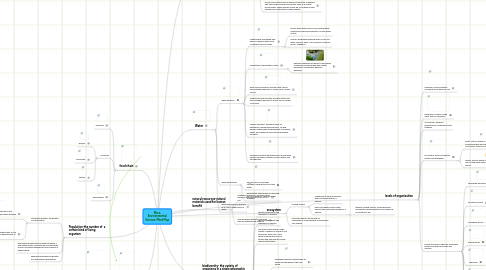
1. food chain
1.1. producer
1.2. consumer
1.2.1. primary
1.2.2. secondary
1.2.3. tertiary
1.3. decomposer
2. food web
2.1. trophic levels
3. Population-the number of a certain kind of living organism
3.1. population growth- the growth of a population
3.1.1. j-curve-a curve of a graph that is very consistantly a straight line before growing exponentially
3.1.2. s-curve-a curve of a graph that starts out as a j-curve, but after it grows exponentially, it levels off.
3.2. population growth rate-the speed at which a population grows, measured by comparing the amount of people being born the of amount of people dying
3.3. exponential growth-the growth of a population exponentially
4. levels of organization
4.1. organism-a living creature consisting of at least one cell
4.2. population-a family of the same type of organisms
4.3. community- different populations of organisms living together
4.4. ecosystem-biotic and abiotic factors living together
4.4.1. biotic factors-things in an ecosystem that are living or were once living, made of cells
4.4.2. abiotic factors-things in an ecosystem that are not and never were living, made of atoms
4.5. biome-the area in which an ecosystem exists including the climate and location
4.5.1. temperate deciduous forest
4.5.2. coniferous forest
4.5.3. freshwater biome
4.5.4. marine biome
4.5.5. rainforest
4.5.6. desert
4.5.7. tundra
4.5.8. grassland/savannah
5. biodiversity- the variety of organisms in a single geographic area
5.1. genetic biodiversity-the difference in genetics.
5.2. species biodiversity-the difference in species
5.3. hot spots-spots where a large variety of species is found in one small area. There are 17 hot spots covering about 2% of earth's land area and are mostly found in the tropics
5.4. species
5.4.1. threatened species-species likely to become endangered in the near future
5.4.2. endangered species-species in danger of extinction throughout most/all land area
5.4.3. indicator species-plants and animals that by their presence, abundance, lack of abundance, or chemical composition demonstrate the healthiness or unhealthiness of an ecosystem
5.5. ecosystem biodiversity-the variety of organisms in an ecosystem
6. Ecological Succession- the process by which and ecosystem recovers from a distaster, man-made or natural
6.1. primary succession-this occurs in a place where an ecsystem has never existed
6.2. secondary succession-this occurs in an ecosystem that has been disturbed/destroyed by a natural/man-made disaster
6.3. pioneer species-smaller, grow faster, require fewer resources, thrive with little competition. these species usually thrive at the beginning of succession
6.4. climax community-this is a diverse community of species that take longer to grow and survive easily in a certain environment. These species usually do not change unless affected by a natural/man-made disaster
7. ecosystem
7.1. limiting factors
7.1.1. conditions of the environment that limit the growth of a species
7.1.2. biotic and abiotic factors that prevent the continuous growth of a species
7.1.2.1. without limiting factors, a species would exceed the carrying capacity and cause the ecosystem to die
7.2. carrying capacity-the number of individuals of a species that an ecosystem can support
8. Water
8.1. water pollution
8.1.1. impermeable-something that does not absorb water such as asphault and roof-tops
8.1.1.1. runoff-water that runs off from impermeable surfaces and carries pollutants to a main water source.
8.1.1.2. erosion-the gradual wearing down of soil and water carries it away. This is usually caused by lack of vegitation
8.1.2. urbanization-the growth of cities
8.1.2.1. wetlands-wetlands are home to thousands of species and help break down water pollutants. Urbanization destroys wetlands.
8.1.3. point source pollution-pollution that can be easily stopped because it comes from a single source.
8.1.4. nonpoint source pollution-pollution that is not easily stopped because it comes from a variety of sources
8.1.5. organic pollutant- pollutants such as detergents, disinfectant products, fat and grease, insecticides and herbicides, fuel waste, debris, and chemicals from personal hygene products
8.1.6. inorganic pollutant-pollutants such as industrial acidity, ammonia, fertilizers, heavy metals, and silt/sediment
8.2. water purification
8.2.1. aquifers-porous rock that contains a large amount of fresh water
8.2.2. desalination-the process of removing salt from water to make the water drinkable
